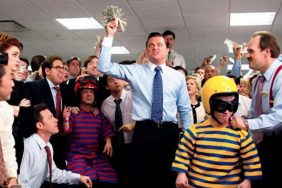Photo: Martin Scorsese and Robert De Niro on the set of TAXI DRIVER (1976). Courtesy of Sikelia Productions (detail).
Martin Scorsese is a master of the dark side of the American Dream, revealing the underbelly of the nation for a wide array of perspectives. From Mean Streets (1973) to The Wolf of Wall Street (2013), over a period of four decades, Scorsese has crafted a body of work that takes on the complexities of life that are further aggravated by a desire to beat the system that almost always destroys them in the end.
Also: TAKI 183, Elusive NY Graffiti Legend, Comes Out of Retirement
And yet, through it all, we find ourselves feeling a deep sense of empathy, a kind of attraction-repulsion that reminds us that life is a messy proposition. Consider Travis Bickle in Taxi Driver (1976) or Howard Hughes in The Aviator (2004): we see one life as it comes to an apocalyptic end, never knowing how it got to be so bad; then we glimpse one man as he forges a path towards glory, knowing just how terrible things will become in his later years, grateful Scorsese has spared us.

Leonardo DiCaprio in THE WOLF OF WALL STREET (2013). Image courtesy of Sikelia Productions.
That is the brilliance of Martin Scorsese. Whether Goodfellas (1990) or Casino (1995), he knows just how to walk the line between the high that comes before the crash, taking on a breathtaking journey through a panopoly of emotions, sensations, and experiences. Now in celebration of the filmmaker’s incredible career, The Museum of the Moving Image, Queens, New York, presents Martin Scorsese, an exhibition that takes you behind the scenes and the world of the mastermind who can do justice to the stories of Jake LaMotta and Jesus Christ alike.
The exhibition, now on view through April 23, 2017, is organized in the categories: Family, Brothers, Men and Women, Lonely Heroes, New York, Cinephile, Cinematography, Editing, and Music. In each section, we are treated to more than 600 archival objects, many drawn extensively from Scorsese’s own collection, including production material from his key films, such as costumes, props, storyboards, set photographs, screenplays, and more; objects from his childhood; and projections of scenes from his work.
Like the best Scorsese film, the exhibition is immersive, catching you off guard as a voice yells out, “Fuck your mother!” The creeping horrors of old New York edge into view, the bright lights, big city vibe that made Times Square the sex capital of the world, reminding us of the town where Scorsese got his start. This impression is further enhanced by a 13-minute video installation featuring four adjacent screens, that have the effect of overwhelming you with a hallucinatory effect, cutting between still and moving images of some of Scorsese’s favorite visual effects.
One of the pleasures of the show is that it reminds you that Scorsese is everywhere; feature, documentary, and television; producer, director, writer. He’s a one-man wonder who delivered Boxcar Bertha (1972), the video for Michael Jackson’s Bad (1987), and Hugo (2011). The detail of the exhibition is as overwhelming as it is addictive, just as a Scorsese film operates, drawing you in. The diversity of materials only adds to the experience, as you begin to feel what it must be like to live inside the mind of Martin the Great.
Miss Rosen is a journalist covering art, photography, culture, and books. Her byline has appeared in L’Uomo Vogue, Whitewall, The Undefeated, Dazed Digital, Jocks and Nerds, and L’Oeil de la Photographie. Follow her on Twitter @Miss_Rosen.
Martin Scorsese
-
"Martin Scorsese" Exhibit at the Museum of the Moving Image

Leonardo DiCaprio and Cate Blanchett in THE AVIATOR (2004, Dir. Martin Scorsese). Image courtesy of Sikelia Productions.
-
"Martin Scorsese" Exhibit at the Museum of the Moving Image

Leonardo DiCaprio (center left) and Daniel Day-Lewis (center right) in GANGS OF NEW YORK (2002, Dir. Martin Scorsese). Image courtesy of Sikelia Productions.
-
"Martin Scorsese" Exhibit at the Museum of the Moving Image

Photo: Martin Scorsese and Robert De Niro on the set of TAXI DRIVER (1976). Courtesy of Sikelia Productions.
-
"Martin Scorsese" Exhibit at the Museum of the Moving Image

A view of the video installation (13 mins) created by curator Nils Warnecke, in the Museum’s video screening amphitheater (on screen: scene from The Last Temptation of Christ (1988). Credit: Photo: Thanassi Karageorgiou/Museum of the Moving Image
-
"Martin Scorsese" Exhibit at the Museum of the Moving Image

Entry area and title sign. Photo: Thanassi Karageorgiou/Museum of the Moving Image.
-
"Martin Scorsese" Exhibit at the Museum of the Moving Image

Movie posters from Martin Scorsese’s personal collection, including “I Vitelloni,” “The Red Shoes,” and “The Life and Death of Colonel Blimp,” appear in the “Cinephile” section of the exhibition. Photo: Thanassi Karageorgiou/Museum of the Moving Image.
-
"Martin Scorsese" Exhibit at the Museum of the Moving Image

Storyboard for MEAN STREETS (1973). Martin Scorsese. Pencil and ink on paper. Martin Scorsese Collection, New York. Photo: Marian Stefanowski, courtesy of Deutsche Kinemathek (Berlin).
-
"Martin Scorsese" Exhibit at the Museum of the Moving Image

In the foreground, a costume designed by Sandy Powell and worn by Cate Blanchett as Kathryn Hepburn in The Aviator (2004). Photo: Thanassi Karageorgiou/Museum of the Moving Image.
-
"Martin Scorsese" Exhibit at the Museum of the Moving Image

The Scorsese family dining room table and chairs. Credit: Photo: Thanassi Karageorgiou/Museum of the Moving Image.








